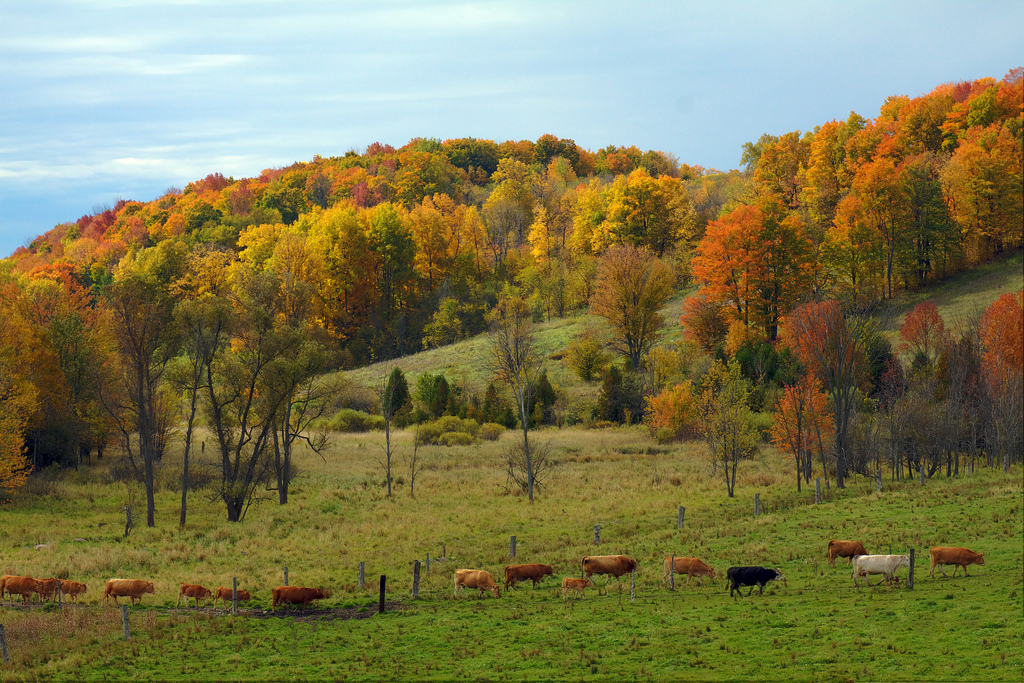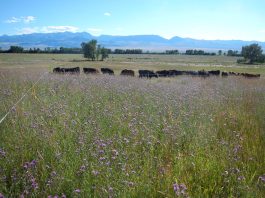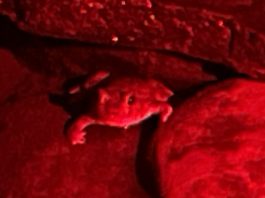This year many farmers are wondering why barnyardgrass is present in unusual abundance in their hay fields and pastures. This annual warm-season grass weed is physically similar to Japanese millet and is found throughout the world. In North America it is found from Mexico to Alaska. This discussion will cover:
- Forage quality and palatability questions and concerns
- Factors that contributed to the problem in 2013
- Crop management implications
Physical description

Depending on growing conditions and the time of germination, mature barnyardgrass plants may be between 1 and 6.5 feet tall. Larger plants with more dense tillering (thick clumps with many shoots) can be expected in areas of very high fertility and/or less frequent harvest. Stems are coarse and may range from 0.15 to 0.5 inches in diameter. Leaves are between 4 and 12 inches long, up to 0.6 inches wide, green in color and occasionally have a reddish hue. Seed heads have a sparse panicle arrangement (i.e., shaped like a ‘Charlie Brown Christmas tree’), generally have between four and seven lateral branches, and may be reddish-purple and/or green in color. Branches of the seedhead range from 0.75 to 2.5 inches long and have bristly seeds densely packed along the length. Roots are dense and fibrous.
First things first: what about the forage quality and palatability?
In absolute terms, barnyardgrass is not very palatable as a pasture forage except in the vegetative stage. As with most weeds, barnyardgrass wastes no time moving from the vegetative stages to the reproductive stage. If low to moderate amounts of barnyardgrass are present in a perennial hay field that is harvested for haylage, palatability of the ensiled product will almost certainly not be affected. Research published by Marten and Andersen (1975) compared the forage quality and palatability characteristics of 12 pasture weeds to oats. At the time the oats were at the early-head stage, the barnyardgrass was still vegetative, and their forage quality parameters compare as follows:
The point here is not that barnyardgrass is a superior forage species compared to oats or anything else, but to demonstrate that barnyardgrass will not harm the forage quality parameters listed above if harvested or grazed at a vegetative stage. As with all grasses, if barnyardgrass is allowed to progress to the reproductive stage the forage quality will suffer greatly.
The researchers in this study used sheep to measure palatability of the various weeds: barnyardgrass was palatable, common ragweed was sometimes unpalatable, and wild mustard was unpalatable. The researchers also tested for alkaloids, compounds which are known to reduce palatability; none were found in any of the grasses tested. The data from the mineral analysis was used to calculate Ca/P ratios, which can indicate if that feedstuff may predispose cows to milk fever. The K/(Ca + Mg) ratios were calculated to determine if any of the forages might be prone to induce grass tetany to grazing livestock. The ratios for barnyardgrass suggest that it is unlikely to induce milk fever or grass tetany. Finally, the nitrate levels were checked for all species in the study. Forages with nitrate levels above 0.35% can induce nitrate toxicity, and some have suggested that barnyardgrass might occasionally have this problem. In this study, however, barnyardgrass had 0.09% nitrates, while oats had 0.10%. Nitrate toxicity is much more likely to occur in barnyardgrass and other forages in drought situations.
Why is barnyardgrass so abundant this year?
As with most weed problems that happen suddenly over a wide geographic area, the cause is environmental.
Interacting factors likely included:
- Dry weather until the last week of May likely delayed nitrogen mineralization which reduced the vigor of early-season forage growth. This left more nitrogen in the soil than would ordinarily be there in early-June. This delayed release held back early growth of the pasture grasses yet coincided nicely with the early growth-stages of barnyardgrass seedlings.
- Record precipitation in late-May through June set the stage nicely for germination and rapid growth of barnyardgrass, which thrives in extremely wet soils, especially if nitrogen is abundant.
- Warm-season grasses like barnyardgrass and corn like hot weather. The temperatures in July and August favored rapid growth of warm-season plants.
For some farms, one or two of this year’s hay cuttings happened on wet soils. In some cases, this led to compaction, which favored retention of surface water and reduced competition from the established perennial plants. Some farmers may notice strips of barnyardgrass oriented in the same direction that the field is harvested.
Could my management practices have made this problem worse?
 Maybe a little. Given the many multifactorial decisions that need to be made each year, mostfarmers have to choose between the ‘lesser of two evils’ several times per year. In this case the choice for many was between taking the first cutting when soils were still somewhat wet during a two day break in the rainy weather as opposed to delaying harvest until soil conditions improved. In many cases, delaying the harvest would be the greater of the evils given the inevitable loss of forage quality that would affect the bottom-line for the rest of the year. In pasture settings, barnyardgrass always has a competitive advantage around watering areas due to higher levels of compaction, abundant nutrients, moisture, and destruction (i.e., reduced competition) of the perennial pasture plants. Given the geographic scope of the problem in the state [Vermont], it is safe to say that fields with certain types of soils probably would have ended up with barnyardgrass this year under many management scenarios.
Maybe a little. Given the many multifactorial decisions that need to be made each year, mostfarmers have to choose between the ‘lesser of two evils’ several times per year. In this case the choice for many was between taking the first cutting when soils were still somewhat wet during a two day break in the rainy weather as opposed to delaying harvest until soil conditions improved. In many cases, delaying the harvest would be the greater of the evils given the inevitable loss of forage quality that would affect the bottom-line for the rest of the year. In pasture settings, barnyardgrass always has a competitive advantage around watering areas due to higher levels of compaction, abundant nutrients, moisture, and destruction (i.e., reduced competition) of the perennial pasture plants. Given the geographic scope of the problem in the state [Vermont], it is safe to say that fields with certain types of soils probably would have ended up with barnyardgrass this year under many management scenarios.
Will it show up again? The seeds that produced the plants we see this year were already in the soil. References to research done on the subject of barnyardgrass seed viability in the soil suggest that most of the seed in the soil seed bank loses viability within three years, but some may survive 13 years or more. Given that barnyardgrass is a prolific seed producer (it can produce 2,000 pounds of seed/ac in a severe infestation) it is reasonable to assume that past infestations made significant contributions to the soil seed bank and that we will probably see it again.
How can this weed be managed in the future?
Knowledge about the particular characteristics of a weed can help the manager make decisions about how to manage it in the future. Barnyardgrass:
- is a warm-season annual grass. It will not be a factor for a timely first cutting, but the plants will grow rapidly thereafter.
- seed production will be heaviest in August and September. Plants will keep attempting to produce seed until cooler temperatures inhibit regrowth.
- favors rich, moist soils and grows well in poorly drained soils.
- is not tolerant of shading by other plants
- thrives when nutrient (particularly nitrogen) levels are high in the soil
- seeds float; moving water is a major mode of seed dispersal.
- can be removed from corn and legume fields with herbicides, but there are no labeled herbicides that will remove it from a grass hay field or pasture.
Conclusion:
 While barnyardgrass is not something that anyone would intentionally plant in their pastures and hayfields, the impact on haylage quality will be minimal unless infestations are very heavy; in a few cases the impact on forage quality may even be positive. To minimize future problems, endeavor to harvest fields before the barnyardgrass produces viable seed. Promoting dense and vigorous growth of your perennial forage species will increase your chances of out-competing barnyardgrass, which is quite intolerant of shade. In pastures, degraded areas will probably continue to favor barnyardgrass until management is changed to so that compaction and physical damage to the perennial forages is corrected. In certain situations where barnyardgrass is a major problem, rotating the field to corn will give the crop manager the option to use herbicides.
While barnyardgrass is not something that anyone would intentionally plant in their pastures and hayfields, the impact on haylage quality will be minimal unless infestations are very heavy; in a few cases the impact on forage quality may even be positive. To minimize future problems, endeavor to harvest fields before the barnyardgrass produces viable seed. Promoting dense and vigorous growth of your perennial forage species will increase your chances of out-competing barnyardgrass, which is quite intolerant of shade. In pastures, degraded areas will probably continue to favor barnyardgrass until management is changed to so that compaction and physical damage to the perennial forages is corrected. In certain situations where barnyardgrass is a major problem, rotating the field to corn will give the crop manager the option to use herbicides.
Editor’s Note: References for this article are available on the Agronomator’s website.






In southern VT and western MA pastures, the problem annual this year was a different warm-season grass: foxtail. Crabgrass was heavy in cultivated fields. The causes were the same as what Dan describes, but on soils that are a bit better drained.
Bruce
Yes Dan, we too have unusual amount of Barnyard Grass, but even more Japanese Stiltgrass and Perilla Mint emerging from fringes of woods well out through our pastures. The cattle like the former but won’t touch the latter (which is toxic). I suppose I’ll have to do some mowing next summer!
Comments are closed.